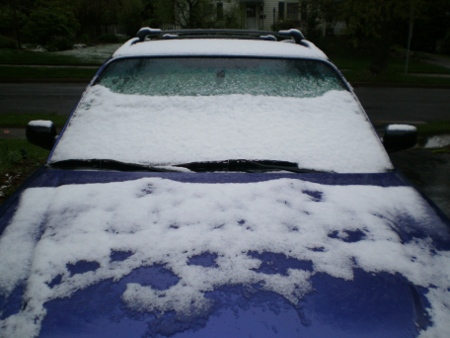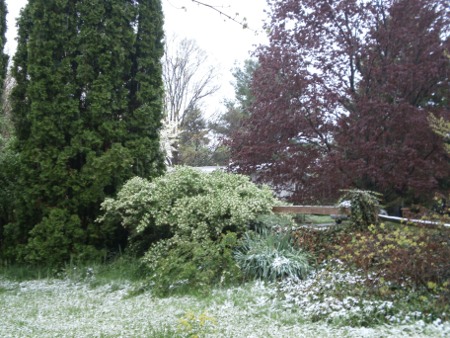We had July weather in March, but April 23rd looks like this.

This is a problem.

Flowers are blooming.

And the trees are in full leaf.

Some places got a lot more snow, and associated power outages. We haven’t had a big snowstorm since October. When, yes, the leaves were on the trees.
I got off lightly: the NWS was originally predicting 4-8 inches, but we got maybe one, and though it’s been snowing on and off all day nothing has accumulated.
The problem with calling it global warming, well, “global warming” is that it isn’t exactly. Changing the composition of gases in the atmosphere traps more solar radiation, which can manifest as warmer temperatures, but also increases the amount of energy in the system.
More energy means changed global circulation patterns, in both the atmosphere and the oceans. Weather patterns will change, in some cases dramatically. In one extreme scenario, the Gulf Stream current could stop, resulting in dramatically colder temperatures in the northeastern United States and especially in northwestern Europe.
More immediately, the increased energy in the global system means more frequent and more intense storms. Tornados anyone?
Increased energy will disrupt established climate patterns in new and unusual ways: 80F in March and snow in late April could become the new normal, exceptfor the years when it snows in March and is 90F in April.
A lot of places will become warmer, especially Arctic and Antarctic regions, and places that are very dry now, like the Southwestern United States. Rainfall patterns will change: wetter or drier, and at different times of year.
I think, though, that the chaos will be the biggest problem.






2 responses to “Digging out: a new perspective”
The energy will have to go somewhere, and the atmosphere (at risk of anthropomorphizing it) will use its usual processes like storms to try to equilibrate itself. It’s very difficult to link climate change to specific events like tornadoes, mainly because of scaling issues. I work at the cloud (and smaller) scale, and there’s no way now to represent those processes in climate models just because of the short time and fine model resolutions required.
And, yeah, I long ago stopped calling “climate change” by the term “global warming,” because it doesn’t work with laypersons when it’s -20 F in a blizzard. :-)
True. Not any specific tornado, but an overall increase in the frequency and severity of tornadoes overall. Same for hurricanes.
I greatly oversimplified, obviously, but the link I gave at the beginning of my digression has good solid information (for people who aren’t weather scientists like Dan).